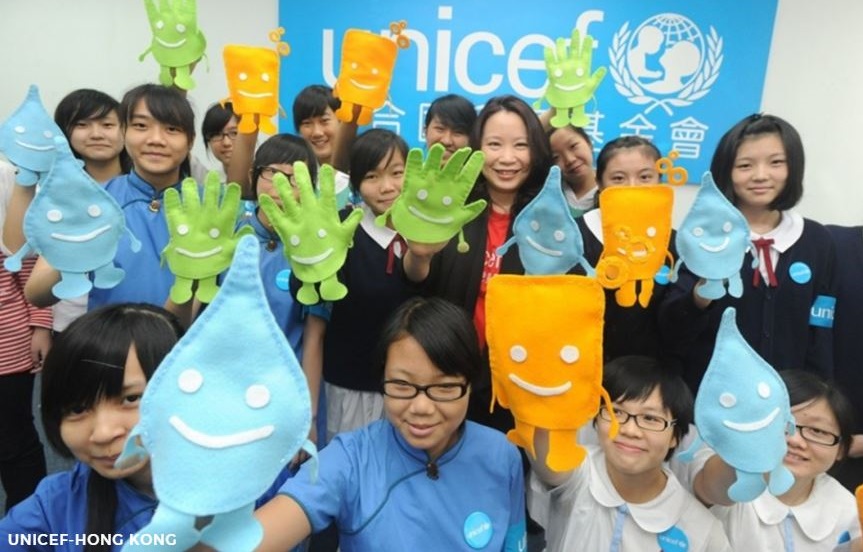Advocacy includes tactics like lobbying key decision makers, organizing demonstrations, and launching media campaigns to persuade decision makers to take action.
Handwashing advocacy usually aims to influence public policy, public opinion, and resource mobilization. For example, advocates can call for handwashing to be included in specific nutrition, education, or child health policies, goals, and targets; demand that local schools deliver hygiene promotion activities; or that authorities take responsibility for measuring people’s access to handwashing facilities.
Handwashing advocates often seek to increase public understanding of and support for the importance of handwashing with soap. This helps put additional pressure on decision makers, and can inspire members of the public to become advocates. Global Handwashing Day is one opportunity to raise public support for handwashing with soap.
Global Advocacy and the Sustainable Development Goals
The Sustainable Development Goals (SDG)—adopted by the United Nations in 2015 and often referred to as the 2030 Agenda—are a shared set of goals aiming to improve the lives of everyone, everywhere. The SDGs are a key driver behind the work of governments and stakeholders from civil society, the private sector, academia, and other organizations. Goal 6 embraces hygiene, alongside water and sanitation. and will be measured by target 6.2, which states:
“By 2030, achieve access to adequate and equitable sanitation and hygiene for all, and end open defecation, paying special attention to the needs of women and girls and those in vulnerable situations.”
For SDG reporting, handwashing is measured by the “Proportion of population using safely managed sanitation services, including a handwashing facility with soap and water”. Handwashing with soap also contributes to goals related to health, nutrition, education, and more. To learn more about the role of handwashing in the SDGs, read our advocacy brief.
While including hygiene in the SDG framework is an important step to drive progress, there continues to be a need for advocacy. Advocates must ensure that policies, investments, and interventions continue to promote handwashing with soap on national and sub-national levels.
National and Local Advocacy
Leaders, including those in government, businesses, and the community, have the power to make decisions that have an impact on handwashing. At the local level, advocates hold these decision makers to account to ensure that handwashing is promoted in their communities. For example, advocates can push local leaders, school officials, or public works departments to ensure that accessible handwashing stations with soap and water are available in key public locations, such as schools.
Country-level decisions have a very important impact on handwashing behaviors. National governments are leading progress around the SDGs, in partnership with other sectors. Ministries of Water, Education, Health, and others are often responsible for determining which public services are prioritized and funded. Advocacy at this level can consist of pushing these key decision makers to fund and drive hygiene projects; to make sure handwashing with soap is included in their health, water, education, nutrition, and related policies; to provide sustainable handwashing infrastructure; or to increase accountability and reporting on successes.
For tools, templates, and ideas for national and local-level advocacy, access our Clean Hands for All hygiene advocacy toolkit.
Advocacy Recommendations
Effective advocacy can have a long-term impact on handwashing behavior, and in turn improve health and well-being. These practices can help your advocacy work be most effective.
Define your goals and audiences
All advocacy efforts should have at least one specific objective (this could be a policy decision, an investment, etc). Then, ensure your audience includes decision makers who have the power to achieve your objective. Decision makers can be at organizational, local, national, and/or global levels.
Use appropriate methods and messages
Understanding your audience is key to developing advocacy messages and deciding how to deliver them. Use the factors that motivate your audience in your messages. This might include the political, economic, and health benefits of handwashing. Deliver your messages through the most appropriate methods. This could include social media, traditional media, public events, one-on-one meetings, or other methods.
Collaborate
By joining forces with others who believe in hygiene, you can maximize the reach of your advocacy work. Collaborating can also help advocates reduce financial burdens related to implementing a campaign, mobilize larger audiences, and engage partner platforms that can result in increased pressure on decision makers. Consider building coalitions around a specific issue, particularly with groups who may be more influential with your audience.
Measure your work
Advocates should consistently measure the results of their work. This includes measuring the influence of your messaging and the extent to which they reach your target audience. It also includes measuring the impact of your work. While it can be difficult to attribute change to advocacy alone, advocates typically measure the extent to which their work contributes (rather than directly leads to) to a desired change.
Read UNICEF’s Advocacy Toolkit for additional recommendations for successful advocacy.
Tools for Advocates
The Global Handwashing Partnership supports hygiene advocates with tools, messages, and ideas. We encourage you to use our resources to strengthen your advocacy:
- Clean Hands for All Advocacy Toolkit
- Global Handwashing Day Planner’s Guide and Social Media Toolkit
- Hygiene – Vital for Sustainable Development Advocacy Brief
- Post-2015 Advocacy Toolkit
Visit our Resource Library for other tools. If you have other questions, or are looking for information not included here, please contact us.
